Each breed or discipline can make a convincing argument that it has the most passionate following among its devotees. If it were a contest, it would be tough to top those from the Morgan world. It is one of those sub-cultures that leads others in the equine industry to think, “Wow, those guys are serious about their horses.”
Sean Travers has that zeal for Morgans. The Tiverton, R.I., shoer specializes in the breed’s footcare, is well versed in its history and understands how his role as the shoer contributes to a horse becoming a champion. And driven by his passion, he is quick to defend the breed from perceptions that the footcare strategies employed by qualified Morgan shoers are improper.
“I think it is largely based in not understanding what the farriers are trying to accomplish with long-footed, gaited horses,” he argues. “The clientele we work with spend a lot of money on these horses, so they expect quality workmanship and professionalism.
“They want someone who will keep the horses competing, healthy and sound. I believe that because of what we do and the attention we have to pay to the feet, that we are better farriers than what some give us credit for.”
Throughout this “Shoeing For A Living” day, Travers makes his case through his work. With solid mechanics, careful measurements and a team approach to footcare, Travers is persuasive on the matter.
7:49 a.m. The day begins with an unconventional start for a farrier — we’re already at the barn Travers will work at. Taylor River Farm is an impressive Morgan training facility in Hampton Falls, N.H. Travers handles the hoof care for the nearly 40 horses here.
The barn is 2 hours or more from his home, depending on how agreeable greater Boston traffic is. With clients spread out across the United States, Travers will work at his clients’ barns for a couple to a few days.
Travers will stay at the owners’ home when at Taylor River Farm, as well as at a couple of other clients’ homes. It goes beyond simply needing a place to stay while away from home for a few days — Travers prefers this level of friendship with clients.
“I know a lot of guys don’t get close to their clients and I understand why,” he says. “It is just how I choose to run my business.”
Travers shoes throughout New England, New York, Michigan, Illinois, North Carolina and Oregon. The account in New York is about the farthest distance he is willing to drive. Travers used to have more clients on the West Coast, but the grounding of flights following the September 11 terrorist attacks compelled him to change his business travel.
“After 9-11, I was stranded in Chicago,” he says. “I was fortunate enough to catch a ride home on a truck owned by a client’s trucking company. I was supposed to go out to the West Coast to do my clients’ horses for the World Championships. Instead, my wife and I drove to Oklahoma City where I shod their horses before the competition.
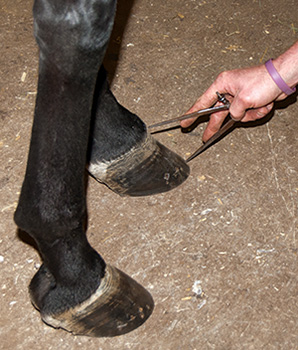
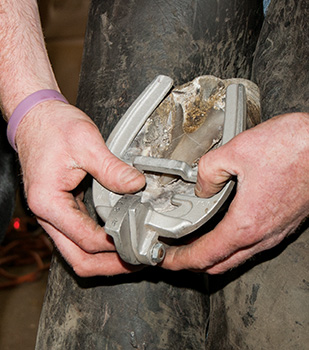
Measuring foot length, left, and angles, right, is necessary for the Morgan shoer to stay within the rules and find what will best help the foot flight.
“After I got home from there, I decided that I wouldn’t travel anywhere that isn’t a 1-day drive from home.”
He does fudge on that rule with the single Oregon client. Credit that to the client’s persistence and willingness to accommodate Travers’ travel plans. Also, there are 12 horses at that barn, so he can get the work done in 2 days.
Although Travers is already at the barn, the horses will have to wait a little bit longer. He will drive to Horseshoes Plus in Barrington, N.H., to pick up a few supplies.
9:18 a.m. A supply shop is an important resource for any farrier’s business. It may be more so for Travers, a top-10 customer of the shop. He views the relationship more as a partnership rather than one of business and consumer.
He says customer service is a strength of this shop, which is owned and operated by Bruce and Rob Cilley. For his New England accounts, the shop delivers Travers’ order to the barn (they have delivery trucks that go out each business day in the morning). For those outside of New England, they will ship the order to that location or his home.
Travers says to work in the show world of long-footed, gaited horses, a farrier needs a reliable supply shop. He adds that the farrier owes some loyalty to that supply shop. This isn’t based on sentiment.
“So much of what a long-footed farrier does involves different shoes, different pads,” he says. “So you may not have all you need. You definitely don’t have time to price-shop when you are working with these horses and need something quickly. It is hard to find a supply house that has all the supplies for long-footed shoers and Horseshoes Plus has everything I need in stock constantly and is reliable for shipments.”
After picking up a few supplies and visiting with the Cilleys, it is time to return to the barn.
During the drive back, Travers describes his family’s passion for Morgans. His parents, Mike and Joan, met as teens showing Morgans and other horses in 4-H, and currently help operate a Massachusetts Morgan farm. His brother, Scott, is a trainer at the same farm. His wife, Terri, is a championship-level competitor and co-founder of HorseShowWire.com, a digital publication covering Morgans and Saddlebreds.
It goes beyond being a family tradition for him. Travers loves working with Morgans because all of the considerations and variables that go into mapping out the horse’s footcare.
“I love the challenge, I’m not the type of person who would look forward to doing the same thing over and over at work,” he says. “I prefer something that allows me to be creative and think.”
10:20 a.m. We arrive back at Taylor River Farm, where Mike Sanborn is waiting for us. An established New Hampshire farrier, he has worked the past 2 years at the barn with Travers. Sanborn has a solid practice that covers various disciplines, but specializes in reiners. He doesn’t have any Morgans on his books and isn’t necessarily looking to change that. So why work with Travers?
“There is going to be something that I learn that I can transfer to my practice — guaranteed,” says Sanborn. “I’ve already learned things about Sean’s approach that have helped me with how I trim the horses I work with. He can take off 1/16th of an inch, which has pushed me to get my trims precise and accurate.
“He gave me a great tip and had me practice my trims on PVC pipe to get that feeling for accuracy.”
It is a typical two-farrier operation — Sanborn will handle tasks like pulling shoes and finishing, and Travers will focus on trimming and nailing on the shoes.
If another farrier wants to ride along and observe, Travers is more than happy to let them do so. To become a helper, he believes in the old-school method of working for free to begin with, because knowledge and experience is a commodity. Travers advises new farriers to pay their dues until they can be helpful for the mentor.
“I look at it like going to college,” he reasons. “College doesn’t pay you to learn, you pay the college to attend. Your time is your payment. A new apprentice, in the beginning, will slow down the person they are learning from, costing that mentor productivity.”
If the helper regularly joins the practice and contributes to the work that day, Travers will pay them.
The Rhode Island shoer has an interesting approach to compensating his helpers. Previously, he would pay a flat fee for the day, but now he pays a percentage of the day’s gross.
“I noticed near the end of a long, exhausting day, I would ask the apprentice, ‘Do you have another horse in you?’” he recalls. “They would be spent and say no because there wasn’t motivation to do another horse. But if doing another horse means more money in their pocket, they have the motivation. That extra horse or two at the end of the day can be a significant amount of money to them.”
It goes beyond having an extra set of hands that day. Working with other farriers like Sanborn allows Travers to share his footcare philosophy and build a network. Because his practice covers a wide range of the United States, Travers can call on one of these farriers to help in an emergency when he is away from that location. Travers says his practice’s success depends on Sanborn and these farriers: Bill Ruh of Michigan, Collin Kimple of Massachusetts, J.R. Swan of Oregon, Mark Schneider of Vermont, Mike Loveland of Michigan and Tim Bolduc of New Hampshire.
10:49 a.m. The first horse of the day is a 4-year-old park saddle mare named Drama. While Sanborn pulls the hind shoes, Travers discusses the horse’s performance with Richard Boulé, the head trainer at Taylor River Farm.
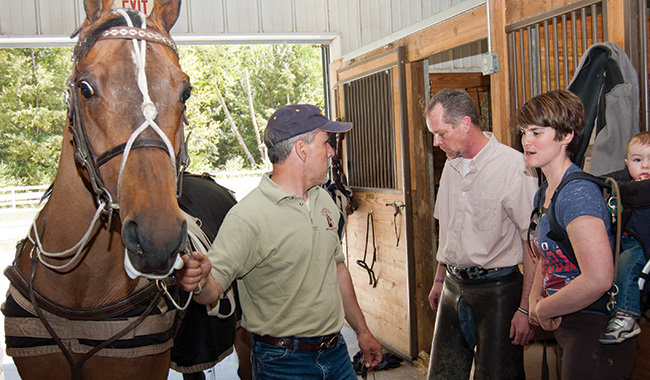
Travers discusses how to approach a horse’s footcare before a show with trainers Richard Boulé, left, and Sarah Gove, right.
Finished with his initial evaluation, Travers starts to trim the feet, beginning with the hinds. Information from the trainer dictates where he starts.
“If the trainer would say, ‘She is going well from behind but needs more help up front,’ I would have started on the fronts,” he says. “But this horse is good all the way around and being a reset, I just start with the hinds.”
And with what will be repeated often today, Travers uses his hoof gauge and calipers throughout the trimming and shoeing process.
“Morgans can be a temperamental breed,” Travers says. “That’s why the accuracy of measurements is so important. There isn’t much margin for error. The mathematics involved from your angles and point of breakover can get intricate. It is like you are shoeing each leg individually.
“If a horse is going to a show in a week or so, I have to use the calipers to measure the length and make sure it will be at the show at or below the required length. The angle of their feet is crucial to the flight of the foot. You may measure and try an angle. Then the trainer works the horse and you find out you may need to go up or down a degree or 2 and make that adjustment.”
This meticulous attention to measurements is driven by two reasons: holding true to the angles and measurements that work for the horse and ensuring the foot is within the rules that govern Morgans. These toe length rules set limits and aren’t necessarily maxed out.
“Each discipline is different,” he says. “Some horses won’t go good with the maximum length. Maybe a horse shouldn’t go at 5 inches; instead it is more comfortable at 4 3/4 inches.”
11:37 a.m. As he trims the front right foot, Travers mentions that the fore right tends to be more dishy, so he wanted to get the toe back so there isn’t as much stress placed on the outside of the toe.
“Now that I have the toe length where I want it, my angle rose from 52 to 54 degrees,” he says. “I want to be cautious in what I remove because you can always take off more, but you can’t add back unless you do so artificially.”
Travers talks about the other feet and the challenge of keeping them where he wants. He checks an index card containing information on the horse to see where he had the horse set on angles from the last shoeing.
“She was at 56 degrees last time, but she hasn’t been done in about 6 to 7 weeks,” he says. “Because of that she’s out of her angle by a couple of degrees. So I took off more toe than heel — just enough to get her back to her comfortable angle.”
Travers records detailed notes on each horse he works on. With the precise measurements and variety of the packages used, it serves as an important reference for him. He documents the type of shoes worn, any modifications to the shoe, pad type, pad thickness, pad degree and foot length.
He finds keeping records is crucial in tracking what didn’t work. Occasionally a trainer will suggest a change that they’ve previously tried with a horse. Although he is open to try new ideas, Travers’ notes can provide evidence that an approach failed before and a different idea is needed.
Due to the nature of the show world, it also could help another farrier down the road.
“Morgans can change owners somewhat frequently,” says Travers. “Mentally, how I view my horses, is that they could be sold tomorrow, and not necessarily to my clients.”
When a horse is sold, a photocopy of Travers’ notes will go with it. He will hang onto the originals in case the horse ever returns to his care, which has happened.
11:50 a.m. The front and hind shoes are resets. On the fronts, he’s using 3/8-by-1-inch handmades, Vettec Sil-Pak, new Keystone Extra Heavy Leather Pads and Curtis Hamilton wedge pads — 3-degree pads on the left, 4 on the right.
“Most horses I shoe don’t wear the same degree pads on the front,” he says. “If I put a 3 on that right, the foot won’t be in control. The steeper angle sucks it back under and keeps it under control.
“Knowing I would be putting a 4 on the right front, I trimmed that foot an 1/8th of an inch shorter than the left in my final trim because that 1/8th of an inch is making up the difference with this pad so the finished toe length is the same left to right.
“This is a park horse, so she’s allowed 5 3/4 inches. I had to take off 3/8 of an inch to get my angles where I need them. With these horses, you need to take off as much foot within reason to get your angles and then add back artificially. In a couple of weeks, with where I left this foot combined with some growth, she’ll be right where I want her for the show.
On the fronts, Travers will use three to four nails laterally and only two nails medially to allow the medial heel to float — #10 nails toward the front and #12 nails toward the heel. He will use a washer with a #12 and drive it through a pre-dilled hole through the pad into the hoof wall to add stability and security for the package.
With a low-angled foot, he finds that the medial quarter often wants to become underslung. For this, he’ll float the quarter and fill it with Play-Doh. Once the Equi-Pak sets, he’ll remove the Play-Doh. When he needs to float a quarter, Travers finds dental impression material won’t dry in time. Travers will float the medial quarter in nearly every case of his high-stepping horse.
“Now there’s no additional pressure on the quarter and it lowers the risk of getting quarter cracks,” he says. “On a tight heel, why not be proactive — float the quarter so there’s no pressure.”
12:14 p.m. Drama is led back to her stall. Before Travers moves on to the next horse, Boulé and trainer Sarah Gove pull him over to consult on two horses. The team looks over a horse named Juicy and reviews what strategy to take with her shoes before the next show.
The second horse, Randy, is exhibiting signs of soreness, so Travers will work the horse into his schedule that day.
Travers prefers accounts like Taylor River Farm because of the teamwork and delegation of duties, as exhibited by the group conference. If owners bring horses there to be trained, the entire team will manage the horse, including Travers as its farrier.
12:31 p.m. Navy is a gelding used as a hunter pleasure riding. The horse is jamming his front right medial quarter and is exhibiting some signs of soreness. Because of the tight heel on Navy, he needs to be addressed every few weeks. Travers will take the shoe off that foot in between resets just to refloat that quarter.
Since it is show season, he will take a more conservative approach by not trimming or changing the pad material. He won’t change anything about the package, feeling that by floating the quarter, putting new Equi-Pak in, and nailing on the shoe, the horse will be show-ready.
Travers nails the shoe back on, but will have Sanborn clinch the foot, sand it and check the clinches on the front left before taking the horse back to its stall.
Travers often refers to the challenges faced with Morgans. He reasons the toughest, or at least the most encompassing, is shoeing a horse in one state for all future conditions.
“You can get a Morgan as perfect as you can when they are standing on a flat concrete or rubber surface,” he says. “But that is the last time that horse is going to be on that perfect surface again. It will go back to a stall, which isn’t perfectly flat. It will go to work in the arena, which isn’t perfectly flat. What is perfect on the barn floor doesn’t mean it is perfect when they perform.
“Sometimes the horse needs the weight of a 3/8- by 1-inch shoe, but it can’t handle the cup that the shoe creates. You’ll have to fill that in some how, like adding a bump pad. Do you go with a regular leather pad which provides some resistance as a bump pad? Do you go with an extra heavy pad that has no resistance? How much traction do you need and what kind of surface will this horse ultimately compete on?”
12:43 p.m. Buddy is a more problematic case. The English pleasure horse lost his front right shoe, tearing off part of its front hoof wall. Travers has Sanborn remove the other shoes. It is show season and this horse needs to compete; time off isn’t an option.
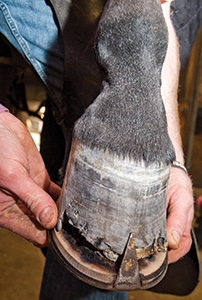
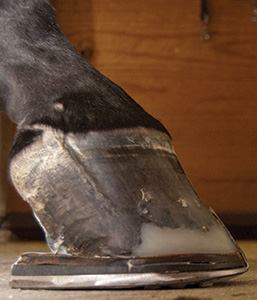
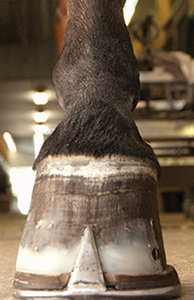
This horse lost its shoe and some hoof wall with it. A show is coming up, so Travers had to reconstruct the missing hoof wall to keep the shoe on.
Travers examines the shoes, noting the wear on the hind ones. He says a shoer in this discipline must be able to recognize what shoe wear can reveal about injuries common to these horses.
“For example, if I look at the medial ground surface and see the medial nails are worn, it usually indicates a hock issue with these performance horses,” he says. “If I see that, I’ll alert the trainer that the hock may be stingy. Then they will pass my notes along to the vet.”
As Sanborn gets the shoes off and cleans the feet, Travers is grinding the heads down on the Cooper #10 Lite nails. He is going to use these nails on the damage foot, because he needs the length of the nail to get to good hoof wall. However the heads are a little large for the shoe he’s using, so he’ll get it close to a city head and have it counter sink into the shoe.
He’ll start with the front right foot, and then move to the hinds. He won’t take off the front left for this job because he matched the right damaged foot in length to the left.
1:26 p.m. Travers is very cautious in driving the nails into the hoof wall. To stabilize the foot, he uses Vettec Super Fast to rebuild the hoof wall that broke off with the shoe. He credits Vettec products as helpful tools for working with Morgans. He uses both Sil-Pak and Equi-Pak as his packing material, but prefers the more rigidity of the latter for most cases.
Almost every horse under Travers’ care uses a Vettec material under a pad. Although temperature is no concern on this pleasant spring day, Travers does work in cold climates during the winter.
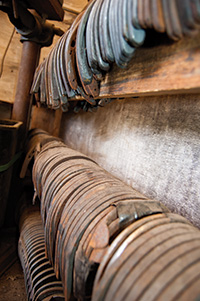
You never know what you’re going to face as a Morgan shoer, so you better be prepared to address changes.
For cold days, he will place a couple of Vettec cartridges on a heating pad, covered with towels. Travers knows what horses he will be working on that day according to his records, so he is certain of how much material he will need under the pads. He will keep the heating pad on high for an hour, and then lower the temperature. This will keep the cartridges at an optimum consistency for his usage.
1:43 p.m. Travers has trimmed the hinds using his G.E. nippers and Heller Black Rasp. Now, he has two plates in the forge, ready to hot shape. He doesn’t hot fit, and he does most of his shaping at the anvil adjacent to the forge in the back of his truck. He uses a stall jack in the barn aisle for any additional light shaping.
While he is doing this, he has Sanborn sand the Super Fast and hoof wall, then finish the foot.
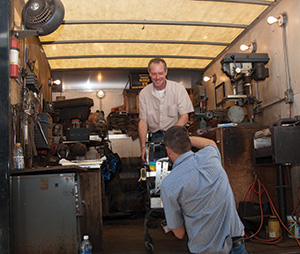
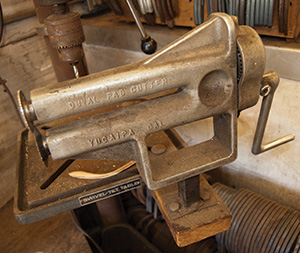
Having worked together for a couple of years shows, as the two have a very natural way of working together without a lot of direction delivered by Travers.
Travers nails on the shoes using his 9-ounce Horsehead hammer, then clinches each foot. He has Sanborn finish these feet.
2:07 p.m. The next horse, a lesson horse, is on schedule for is regular hoof care. Travers refers to his notes, as Sanborn pulls shoes and preps the feet.Travers trims the feet, taking off just enough to maintain his angles. He then steps up into the back of his Chevy 3500 to heat the hind shoes for a reset. For the most part, the tools and set-up are not much different than what you may find among other farrier rigs. The noticeable difference is the amount of supplies he carries, such as pads of various material and width. It may seem excessive, but it is necessary for working with the many disciplines and levels of Morgans he encounters in his practice.
“I don’t even want to know how much inventory I have,” he says. “But I have to carry this level of inventory because on any given day I have to shoe a champion show horse or a 25-year-old lesson horse that needs a heart bar or Myron McLane pad. I need this depth of inventory at the shops I work in throughout the country.”
For the accounts he flies to, Travers wants them to provide him with a set-up that mimics what he has on his truck. He travels with a small kit of a few preferred hand tools, but the clients are responsible for buying and storing all of the hand and power tools, forge and propane. After he finishes the last horse and before he leaves, he will run through the inventory and order necessary supplies through Horseshoes Plus, alerting them to when he will return to that barn.
2:25 p.m. While working with the front left foot, Travers says it is important for Morgan farriers to know their bloodlines. This will key you in on certain conformational characteristics that get passed down to offspring.
It isn’t a guarantee of any certain trait, but if you’ve worked with any of the horses in the bloodline, he says you can inform the owner of some things to look for. Travers works on quality Morgans with inherent talent traits.
“These horses are naturally gifted, naturally talented,” he says. “My job as the farrier is to enhance that, to help perfect that.”
2:49 p.m. With the school horse finished, Randy is back. Having been walked earlier, he exhibited no signs of pain. A few minutes prior in the ring, he exhibited some soreness, but appears sound while walking back and forth on the concrete aisle.
There is a show coming up, so Travers is hesitant in removing the shoe to use the hoof testers. Again, the horse walked fine in tight circles in the aisle.
However, a few minutes later, the soreness reemerged in the practice arena, so the trainer brings the horse to Travers. He pulls the shoes and finds a small abscess near the lateral bar. Abscesses are uncommon among Travers’ horses, but this horse has a history of them.
Travers will return in 5 days to reattach the shoe. Until then, the staff will intermittently soak the horse’s sore foot.
3:34 p.m. With Randy back in his stall, Travers won’t work with any other horses today. He gives the invoice to Jared Gove, the farm manager.
For his New England and New York accounts, the clients are expected to pay on the day of service. For the clients Travers flies to, there are additional charges, including airfare and rental cars. His wife, who manages his billing, will make arrangements for the few clients who prefer to pay via the online payment service PayPal.
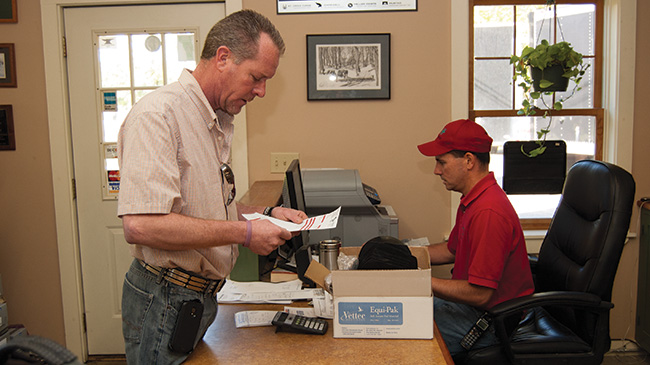
Because packages are so greatly affected by variables, Travers says it is critical for the long-footed farrier to have a good relationship with a supply shop for when you are in a pinch. He credits Bruce and Rob Cilley, right, for helping his practice.
Travers prefers PayPal simply because the ease of use and familiarity of the service among his clients. It also works well for the clients as the service is based on credit card charges.
“If I’m here for a few days or a week, it is going to be a substantial bill,” says Travers. “If they pay by credit card, I still get paid right away and it gives the barn 30 days to bill and collect from their customers.”
Sanborn helps load the truck and mentions he has two of his own clients to see before going home. Travers himself will head back to Rhode Island for 2 days. He’ll then shoe elsewhere in New England for nearly a week, with an important show coming up in Boston.
Once that’s done, his summer will remain hectic, with driving across New England and taking flights across the U.S. It all culminates with the Morgan Grand National and World Championship in October.
Maybe the demands are high and the schedule busy, but Travers wouldn’t have it any other way. He enjoys the constant change, likes working with his clients and is driven by the challenge of keeping his horses sound and competing.
There’s the adage that if you choose a job you love, you’ll never work a day in your life. It seems that “Shoeing For A Living” was the right choice for Travers.

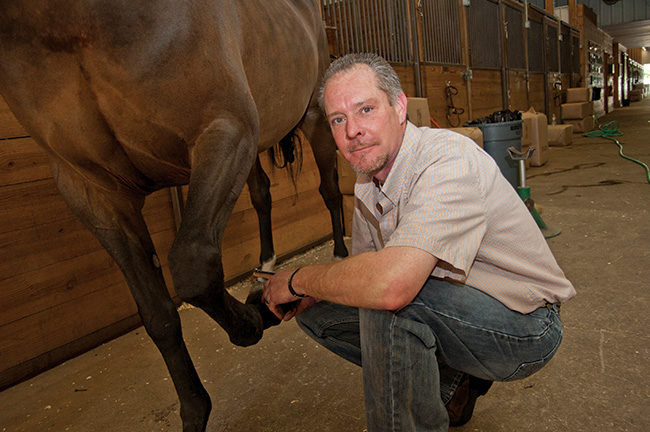







Post a comment
Report Abusive Comment